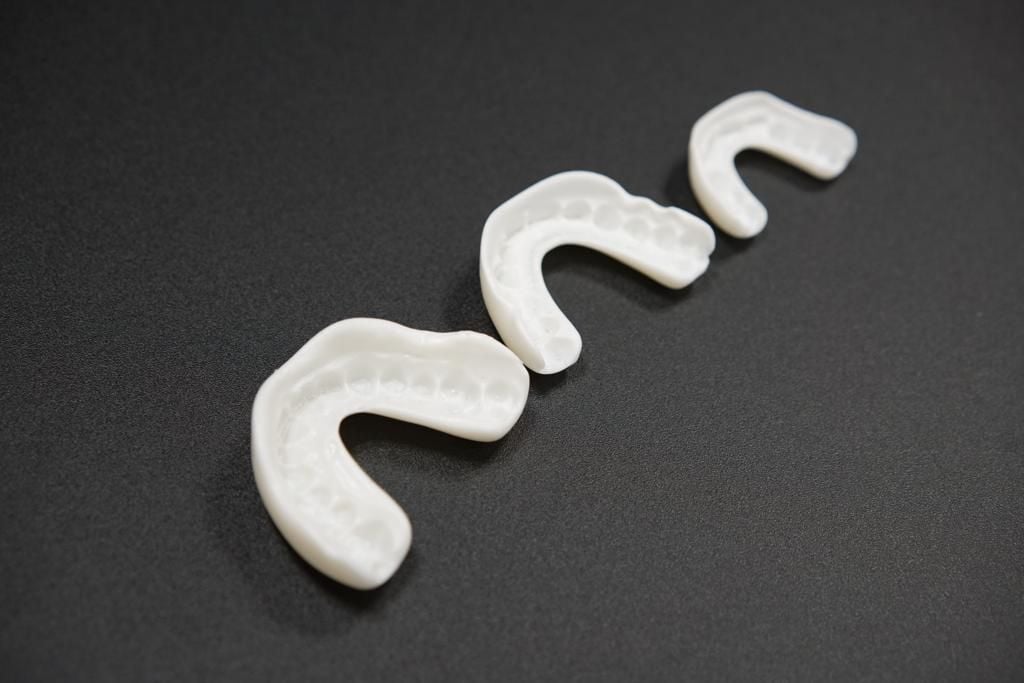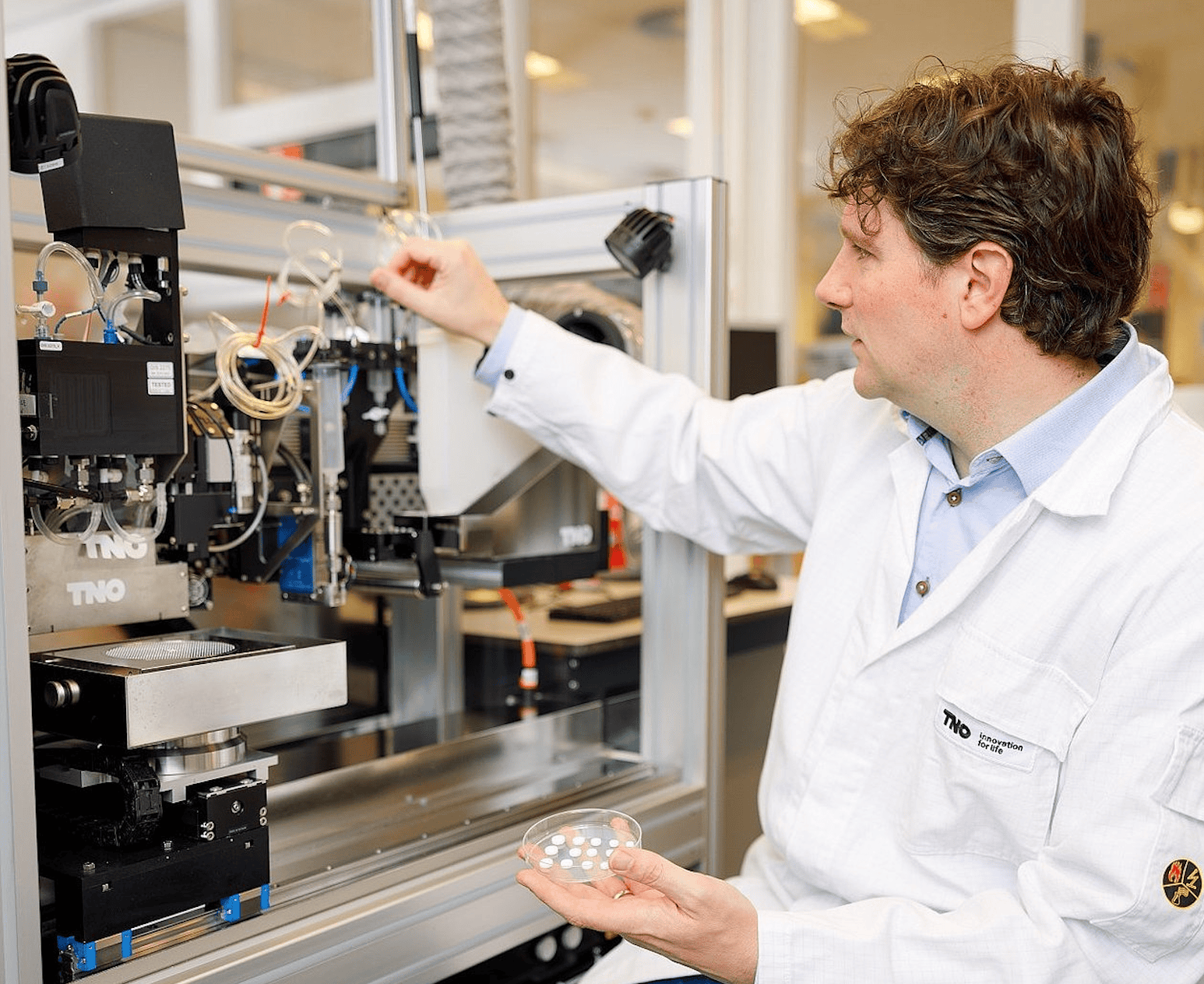
To 3D print an end product without the customer knowing it has been 3D-printed. That is the ambition of Maarten van Dijk from AMcubator and now also from 3Dmouthguard. “Often companies use 3D printing as a selling point. It’s much more powerful if it’s not so much about 3D printing, but rather about what problem it solves.” Van Dijk has developed a production process for the start-up 3D Mouthguard that allows it to print about 150 thousand custom-made mouthguards per year. “We want to eventually get up to a production of 5 million per year,” he says.
The start-up 3Dmouthguard has developed a process that lets it scan an athlete’s upper jaw, send that model to a 3D printer, which then prints a fully customized mouthguard within 45 minutes. A fine start, says Van Dijk, “but ultimately not a scalable technique.” Using this procedure, 3Dmouthguard can make about 10 mouthguards per printer per day.
World market
“That doesn’t put a dent in the market yet,” says Arno Hermans, co-founder of 3Dmouthguard. “You can’t make a good business case out of that. At BIC (Brainport Industries Campus, ed.)together with Maarten, we’ve now actually managed to be the first in the world to achieve high volumes thanks to a different form of printing.”
Hermans estimates that globally there is a worldwide market of around 50 million custom-made mouthguards per year. Wearing a mouthguard is compulsory in field hockey. Ice hockey players, basketball players, rugby players and kickboxers also use them. With the new technology, the company can make 250 mouthguard a day and about 150 thousand mouthguards per year. Hermans: “We aim to serve 10 percent of the world market by 2025.”
In order to really make a difference, high volumes are needed. Van Dijk joined the start-up earlier this year and focused on industrializing the product. That’s where his expertise lies. Together with the founder of the 3D printing company, Marketiger, Maikel de Wit, Van Dijk launched AMcubator last year. A ‘one-stop shop’ for industries that are keen to use 3D printing as a manufacturing technology. This company focuses on accelerating the development of 3D printed parts in high volumes. Van Dijk: “What you often see with 3D printing is that a wide variety of products are being printed. Because of that, you often miss out on the advantage in the market.”
Laser
“The guys at 3Dmouthguard took a very important step before I joined them. Namely, they validated their product in the market. So they know that when they bring the mouthguard onto the market, there will be people who actually want to buy it.”
Hermans and co-founder Victor Beerkens showcased their mouthguard to dentists, sports enthusiasts and sports retailers at home and abroad. Richard van der Oost joined in and designed the conversion software to be able to make a mouthguard automatically from a scan. A joint venture was set up with a company that sells scanners, Carestream Dental (a Kodak spin-off), and with a Latvian company for making the 3D printers, Mass Portal. DSM Additive Manufacturing, now known as Covestro, developed the material for the mouthguards. Interested parties around the world have already found their way to the start-up.
Read more about the 3Dmouthguard start-up here.
Using an existing 3D printing technique, called selective laser sintering, Van Dijk also developed a manufacturing process that enables 3Dmouthguard to achieve higher volumes of high quality products. “A year ago, they were still using a filament printer. That’s a printer where strands are fed into it and you build up the mouthguard with that layer by layer.”
A not particularly fast or stable process, according to Van Dijk. He and Van der Oost set up the production process so that the scan of the teeth is automatically converted into data that the printer uses to speedily print a mouthguard. “It’s completely digitalized and automated so that you can also keep the costs down.”
Separate companies
There had to be a different form of the material, though, Van Dijk goes on to say. “In powder form and not in strands.” For this, he worked intensively with Covestro DSM. “That material also has to be suitable for putting in a person’s mouth. The right kind of certification is also needed for that. Because of the collaboration with Covestro DSM, we were able to accomplish that within a short period of time.”
Collaboration is really key, says Van Dijk. “That is quite typical of Brainport Eindhoven. If we go to a production of 5 million per year, that’s good for all of the partners. Covestro DSM will sell more, and more scanners are sold. Shapeways, which actually prints the mouthguards for us, can produce more of them. They are all various separate companies, but with the same goal. That’s a really great way to work together.”
More widely known
That Brainport Industries Campus (BIC) brokered the collaboration has advantages not only in terms of technology, Van Dijk explains further. “Also in terms of the workforce. With Fontys and the Summa College, you always have students who can show you the latest techniques. We have plans to make this new technology part of the curriculum so that we can transfer our knowledge to the students. We want to make sure within BIC that the companies that use 3D printing and scanners also have people with the right expertise. This is how we will get the employees of the future.”
During the 3D printing Formnex trade fair in Frankfurt, 3Dmouthguard unveiled their high-volume technology to the wider world. Together with its partners, the start-up presented the scan and printer at the Brainport Eindhoven stand. On December 8, during 3D Delta Week, a masterclass on scalable production for high volume additive manufacturing applications for Health will be given during which Van Dijk and Hermans will discuss their production process and what it can mean for healthcare and sports.
Click here for the full program of the 3D Delta Week.





